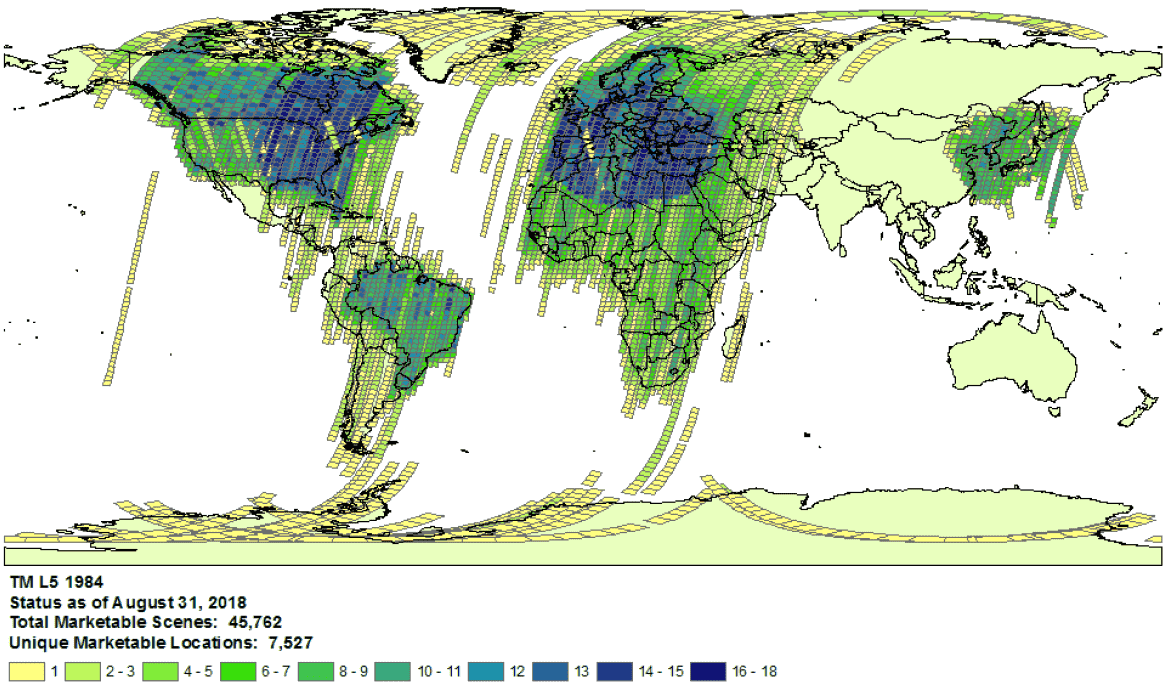Tujuan dokumen ini adalah untuk membantu Anda menentukan apakah aset tidak ada di Katalog Data Earth Engine (saat ini Landsat, Sentinel, dan MODIS).
Langkah-langkah yang diuraikan menjelaskan cara:
Periksa aset yang tersedia di katalog Earth Engine dan penyedia.
Kumpulkan informasi yang diperlukan untuk mengirimkan konfirmasi aset yang tidak ada ke tim data Earth Engine.
Hal umum yang perlu dipertimbangkan
Tingkat pemrosesan: tidak semua gambar mungkin tersedia untuk tingkat pemrosesan atau produk tertentu. Misalnya, gambar berkualitas rendah mungkin tidak diproses ke tingkat tertinggi.
Cakupan spasial-temporal: ritme reguler tidak dijamin untuk setiap set data. Variasi dalam tugas sensor, kualitas gambar, dan pengelolaan arsip dapat memengaruhi ketersediaan data penyedia.
 Contoh cakupan koleksi Landsat 5 untuk tahun 1984.
Contoh cakupan koleksi Landsat 5 untuk tahun 1984.
- Pilihan penyedia: data diserap ke dalam Earth Engine Data Catalog dari penyedia yang dipilih per set data. Mungkin penyedia tidak menawarkan arsip misi lengkap. Misalnya, set data Landsat ditransfer dari arsip USGS, yang diketahui tidak memiliki citra dari stasiun penerima tertentu selama jangka waktu tertentu (lihat upaya LGAC untuk mengetahui informasi selengkapnya).
Landsat
Data Landsat diserap dari U.S. Geological Survey (USGS).
Konfirmasi ketersediaan cakupan Landsat untuk waktu dan area yang diinginkan.
Lakukan penelusuran di Earth Engine untuk mendapatkan daftar semua aset untuk waktu dan area minat. Pastikan tidak ada aset yang tidak sengaja difilter dalam kode Anda. Berikut adalah contoh skrip; pastikan Anda mengimpor koleksi dengan tingkat dan tingkat pemrosesan yang tepat (pelajari lebih lanjut struktur koleksi Landsat).
Cari aset yang mungkin tidak ada di katalog USGS Earth Explorer (lihat panduan bantuan untuk mengetahui langkah-langkah mendetail tentang melakukan penelusuran dan memilih set data). Pastikan Anda membandingkan produk dan tingkat pemrosesan yang tepat (lihat struktur pengumpulan Landsat). Perhatikan bahwa produk pantulan permukaan hanya dibuat untuk gambar Landsat dengan level pemrosesan L1TP.
Bagikan bukti mendetail tentang aset yang tidak ada dengan mengirimkan pesan bersama ID produk penyedia dan link ke skrip Earth Engine Code Editor yang mengonfirmasi tidak adanya aset.
Sentinel
Data Sentinel diserap dari situs Copernicus Dataspace.
Pastikan ketersediaan cakupan Sentinel untuk waktu dan area yang diinginkan (lihat detail misi).
Catatan: Produk Sentinel-2 Level-2A dihasilkan secara sistematis di segmen darat di Eropa hanya sejak Maret 2018, dan produksinya diperluas ke seluruh dunia pada Desember 2018 (lihat Panduan Pengguna ESA untuk mengetahui detail selengkapnya). Cuplikan tersebut pada akhirnya akan dibuat ulang sebagai bagian dari Koleksi 1.
Lakukan penelusuran di Earth Engine untuk mendapatkan daftar semua aset untuk waktu dan area minat. Pastikan tidak ada aset yang tidak sengaja difilter dalam kode Anda. Berikut adalah contoh skrip; pastikan Anda mengimpor koleksi dengan tingkat pemrosesan yang tepat.
Cari aset yang mungkin tidak ada di katalog Copernicus.
Bagikan bukti mendetail tentang aset yang tidak ada dengan mengirimkan pesan bersama ID produk penyedia dan link ke skrip Earth Engine Code Editor yang mengonfirmasi tidak adanya aset.
MODIS
Data MODIS diserap dari Land Processes Distributed Active Archive Center (LP DAAC).
Lakukan penelusuran di Earth Engine untuk mendapatkan daftar semua aset untuk waktu dan area minat. Pastikan tidak ada aset yang tidak sengaja difilter dalam kode Anda. Berikut adalah contoh skrip; pastikan Anda mengimpor produk yang diinginkan.
Cari aset yang mungkin tidak ada di Koleksi Data USGS yang belum ditambahkan ke Earth Engine. Buka folder yang sesuai dan identifikasi direktori terbaru yang tersedia.
Set data yang diawali dengan "MOD" berada di "Terra MODIS"
Set data yang diawali dengan "MYD" berada di "Aqua MODIS"
Set data yang diawali dengan "MCD" berada di "MODIS Gabungan"
Set data yang diawali dengan "VNP" berada di "S-NPP VIIRS"
Bagikan bukti mendetail tentang aset yang tidak ada dengan mengirimkan pesan bersama ID produk penyedia dan link ke skrip Earth Engine Code Editor yang mengonfirmasi tidak adanya aset.
